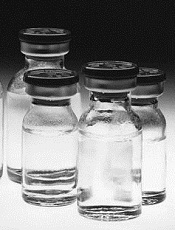
Credit: Bill Branson
Counter to its previous recommendations, the UK’s National Institute for Health and Care Excellence (NICE) is now supporting the use of pixantrone for certain patients with non-Hodgkin lymphoma (NHL).
In prior draft guidance documents, NICE said it could not recommend the antineoplastic agent for patients with relapsed or refractory NHL, due to concerns about efficacy and cost.
But now, in its final draft guidance, the agency has said pixantrone should be funded by the National Health Service to treat certain patients with B-cell NHL.
NICE is recommending pixantrone for patients with relapsed or refractory disease who have already received rituximab and are receiving their third- or fourth-line treatment.
The NICE guidance also says pixantrone can only be funded if the manufacturer, Cell Therapeutics, provides the drug at a discounted rate, as agreed between the manufacturer and the Department of Health.
“We are pleased that the manufacturer was able to provide a patient access scheme,” said Carole Longson, NICE Health Technology Evaluation Centre Director. “Pixantrone will be a useful addition to the treatment options available.”
Consultees now have until January 23, 2014, to appeal the draft recommendation. If no appeals are lodged, the final guidance should be published in February.
Clinical effectiveness
NICE’s current recommendations are based on the opinion of an independent appraisal committee. The committee considered data from the EXTEND PIX301 clinical trial. The committee said there are a number of uncertainties associated with this trial.
However, the group also said there was limited evidence suggesting that pixantrone works better than other available treatments for patients who had previously received rituximab and patients receiving third- or fourth-line treatment.
The EXTEND PIX301 trial enrolled 140 patients with aggressive B-cell lymphoma. Half of the patients were randomized to receive pixantrone and the other half to their physicians’ choice of treatment.
At the end of treatment, confirmed and unconfirmed response rates for the intent-to-treat population were significantly higher in the pixantrone arm than the comparator arm—20% and 5.7%, respectively (P=0.021). The same was true after 18 months of follow-up—24.3% and 7.1%, respectively (P=0.009).
The median progression-free survival was significantly longer in the pixantrone arm than the comparator arm—5.3 months and 2.6 months, respectively (P=0.005). But there was no significant difference in median overall survival—10.2 months and 7.6 months, respectively (P=0.251).
Cell Therapeutics also submitted results observed in 4 subgroups of patients with aggressive disease and in patients who had previously received rituximab. For detailed data from the trial, see pages 3 through 13 of the final draft guidance.
Cost-effectiveness
The appraisal committee said the manufacturer’s patient access scheme (the details of which are commercial-in-confidence) improved the cost-effectiveness of pixantrone.
The treatment would be cost-effective for patients who had previously received rituximab and patients receiving their third- or fourth-line treatment. The drug’s incremental cost-effectiveness ratio was estimated to be under £22,000 per quality adjusted life year gained for both groups.
According to the manufacturer, pixantrone costs £553.50 per 20 mL vial, excluding tax. The estimated cost of a course of treatment is £19,926.
The costs were calculated over 4 cycles using an average of 3 vials per dose and were based on the median length of treatment in the EXTEND PIX301 trial. Costs may vary in different settings because of negotiated discounts.
Marketing authorization
Pixantrone has conditional marketing authorization in the European Union as monotherapy for adults with relapsed or refractory NHL who have received at least 2 previous lines of treatment. However, the European Medicine’s Agency has noted that it is unclear whether pixantrone is effective as fifth-line or greater treatment in refractory patients.
The drug’s marketing authorization is linked to results of the phase 3 PIX306 trial, which is investigating pixantrone plus rituximab versus gemcitabine plus rituximab in patients with relapsed or refractory B-cell NHL who have previously received a rituximab-containing regimen.

